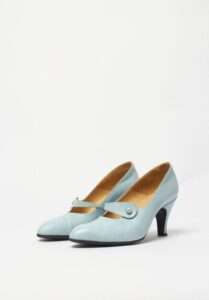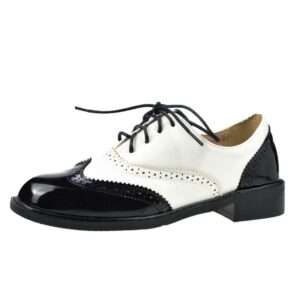50s Shoes shows that the decade was very elegant and charming. These types of shoes – from neat and clean looking loafers to elegant pumps – were the epitome of the time. All of them represent the style, but at the same time, simplicity of the 1950s and it is possible to see it in each pair of shoes. Learn how these classic designs are still incorporated in today’s trends and why vintage shoes will always be in style.
Table of Content
- Classic 50s Shoe Styles
- Iconic Brands and Designers of 50s Shoes
- Impact on Modern Fashion
- How to Incorporate 50s Shoes Today
- Care and Maintenance Tips for 50s Shoes

50s-Shoes
Classic 50s Shoe Styles
Oxfords
Oxfords were a quintessential part of 50s fashion, favored for their polished, formal look. These lace-up shoes typically featured a low heel and a smooth, leather finish. They were flexible enough to be worn with both suits and casual outfits. For an authentic 50s vibe, choose Oxfords in classic shades like black or brown. To maintain their timeless appeal, opt for a pair with minimal decorations and a streamlined silhouette. Expert advice suggests investing in high-quality leather Oxfords, as they age well and offer lasting comfort.
Loafers
Loafers gained popularity in the 50s for their relaxed yet stylish appearance. These designers often made slip-on shoes from leather or suede, known for their ease of wear. They came in various designs, including those with tassels or penny detailing. For a true 50s look, select loafers with subtle, classic elements like a small metal ornament or a simple strap.
Pumps
Pumps were the definitive choice for women’s formal footwear in the 1950s. Characterized by a closed toe and a modest heel, they offered a graceful yet practical option for various occasions. Most 50s pumps featured rounded toes and a sleek, simple design. To capture the elegance of the era, opt for pumps in classic shades like black, beige, or navy. These shoes can easily elevate any outfit, making them a flexible addition to your wardrobe.
Mary Janes
Mary Janes were beloved for their charming and youthful design. These shoes typically had a rounded toe and a single strap across the instep, which secured the foot and added a touch of whimsy. They were popular among both children and adults, often paired with dresses or skirts. For an authentic 50s look, choose Mary Janes with a low, chunky heel and a simple buckle or button.
Brogues
Brogues were a stylish choice for men in the 1950s, known for their distinctive perforated patterns and wingtip design. These shoes combined formal elegance with a touch of ruggedness, making them suitable for both business and casual settings. A classic pair of brogues would be made from high-quality leather in shades such as black or brown, featuring detailed stitching and a polished finish.
Iconic Brands and Designers of 50s Shoes
Impact on Modern Fashion
Timeless Appeal
The classic styles of 50s shoes, like Oxfords and pumps, have an enduring appeal that continues to resonate today. Their clean lines and elegant shapes make them flexible enough to complement both casual and formal outfits. Modern fashion often incorporates these elements, showing how the understated class of 50s footwear remains relevant and stylish.
Revival of Vintage Trends
Vintage fashion has seen a significant revival, with many designers and brands drawing inspiration from the 1950s. This resurgence includes footwear, where retro styles such as Mary Janes and loafers are reimagined with contemporary twists. This revival highlights the 50s’ influence on today’s fashion, bringing classic designs back into the spotlight and making them accessible to a new generation.
High-Quality Craftsmanship
The 1950s were known for their emphasis on quality and craftsmanship in footwear. Brands of that era prioritized well-made, durable shoes, setting a high standard for the industry. Modern fashion continues to value this craftsmanship, with many contemporary brands striving to replicate the careful attention to detail found in 50s designs. This focus on quality ensures that classic styles endure and remain a staple in today’s fashion landscape.
Mixing Old and New
Today’s fashion often combines classic 50s shoe styles with modern elements to create unique, fresh looks. For instance, traditional brogues might be paired with contemporary outfits, or vintage-inspired pumps might be updated with bold colors or materials. This blending of old and new allows fashion enthusiasts to enjoy the elegance of the 1950s while adapting it to current trends.
Influence on Footwear Design
The innovative designs of 50s shoes have had a lasting impact on modern footwear. For example, Salvatore Ferragamo’s iconic bow pumps and Christian Dior’s classy designs have inspired current footwear collections. Modern designers often incorporate similar details, such as refined decorations and elegant shapes, paying homage to the classic styles of the 1950s while adding their own contemporary flair.
How to Incorporate 50s Shoes Today
Pair with Modern Outfits
Combine classic 50s shoes with contemporary clothing for a stylish contrast. For example, wear sleek black Oxfords with skinny jeans and a tailored blazer to achieve a classy, yet modern look. Loafers can be paired with casual trousers and a button-down shirt for a polished, everyday outfit. Mixing these vintage-inspired shoes with current trends creates a balanced outfit that nods to the past while staying firmly in the present.
Add Vintage Flair to Casual Wear
Incorporate 50s shoes like Mary Janes into your casual wardrobe to infuse a touch of retro charm. For instance, pair Mary Janes with a modern skirt or a pair of well-fitted jeans. This blend adds a unique, vintage twist to your casual outfits without overwhelming them. Loafers also work well with casual attire, providing a refined yet relaxed vibe. This approach allows you to enjoy the classic appeal of 50s footwear in a way that fits everyday life.
Opt for Classic Colors
When choosing 50s-inspired shoes, stick to classic colors like black, brown, or navy. These shades are flexible and can easily integrate into various outfits. Black pumps, for example, are perfect for both formal and casual occasions, while brown loafers complement a range of wardrobe pieces. Classic colors ensure that your footwear remains stylish and adaptable, allowing you to mix and match with different outfits effortlessly.
Mix with Modern Accessories
Elevate your look by pairing 50s shoes with contemporary accessories. For instance, modern pumps or loafers can be complemented by a sleek, minimalist handbag or bold, geometric jewelry. This combination helps blend vintage charm with modern aesthetics, making your outfit feel fresh and current. Accessories add a contemporary touch that enhances the classic style of your footwear, creating a balanced and fashionable look.
Embrace the Retro Vibe
Fully embrace the vintage aesthetic by integrating other retro elements into your outfit. Combine 50s-inspired shoes, like brogues or elegant pumps, with vintage-style dresses, high-waisted skirts, or tailored trousers. This approach creates a cohesive retro look that celebrates the elegance of the 1950s. Additionally, incorporating classic hairstyles and makeup can further enhance the vintage feel, making your entire outfit a stylish homage to the past while showcasing your personal flair.

50s-Shoes
Care and Maintenance Tips for 50s Shoes
Regular Cleaning
Keep your 50s shoes looking their best by cleaning them regularly. For leather shoes, use a damp cloth to wipe off dirt and stains. For suede or fabric shoes, a gentle brush can help remove surface dust. Regular cleaning prevents buildup and maintains the shoe’s appearance.
Proper Storage
Store your vintage shoes in a cool, dry place to avoid damage. Use shoe trees to help maintain their shape and prevent creases. Avoid direct sunlight and humidity, which can cause the material to deteriorate or fade.
Condition and Polish
Leather shoes benefit from periodic conditioning and polishing. Apply a leather conditioner to keep the material supple and prevent cracking. Use a shoe polish or cream to restore color and shine. For best results, choose a polish that matches the shoe’s color.
Repair and Re-sole
Address any wear and tear promptly. If the soles show signs of damage, you should consider having a professional cobbler re-sole them. You can often repair minor scuffs or scratches with specialized products or by a professional, which helps ensure the longevity of your vintage footwear.
Avoid Excessive Moisture
Protect your shoes from excessive moisture, which can damage the material. Air dry your wet shoes at room temperature. Avoid placing them near direct heat sources, as this can cause the leather to crack or warp. For suede, use a suede protector spray to help repel moisture and stains.
FAQ’s on 50s Shoes
How do I clean my 50s shoes?
For leather shoes, use a damp cloth to remove dirt and stains, then apply leather conditioner. For suede or fabric shoes, brush gently with a suede brush or a soft cloth.
What’s the best way to store vintage shoes?
Store them in a cool, dry place, away from direct sunlight. Use shoe trees to maintain their shape and prevent creasing.
How often should I polish my 50s shoes?
Polish leather shoes every few weeks or as needed to maintain shine and color. Regular conditioning also helps keep the leather supple.
Can I repair damaged 50s shoes myself?
You can treat minor scuffs or scratches with specialized products. For significant damage or re-soling, it’s best to consult a professional cobbler.
How can I prevent my 50s shoes from getting damaged by moisture?
Keep shoes dry and avoid exposing them to excessive moisture. If wet, let them air dry naturally, away from direct heat sources. Use a moisture repellent for added protection.
Conclusion
Classic 50s shoes hold a timeless allure that continues to captivate fashion enthusiasts today. Their elegant designs and high-quality craftsmanship have left a lasting impact on modern fashion, seamlessly blending with contemporary styles. By incorporating these vintage-inspired shoes into your wardrobe, you can add a touch of retro charm while enjoying their enduring class. With proper care and maintenance, your 50s shoes can remain a stylish and functional part of your collection for years to come. Embrace the elegance of the past and let these classic styles enhance your modern fashion sense.
Source by:
Written by: bioleather.in
